Director’s Introduction
Hilton Lewis, Director, WMKO
 Aloha and welcome to the winter edition of the Observers’ Newsletter. It is my pleasure to report on some spectacular discoveries made recently at the W. M. Keck Observatory, on some very exciting new funding results and on the progress of new capabilities that will become available later this year.
Aloha and welcome to the winter edition of the Observers’ Newsletter. It is my pleasure to report on some spectacular discoveries made recently at the W. M. Keck Observatory, on some very exciting new funding results and on the progress of new capabilities that will become available later this year.
The W. M. Keck Observatory telescopes continue to be the most scientifically productive ground-based telescopes on a per-telescope basis, both in terms of papers published and impact, as measured by citations of those papers. Among the discoveries recently achieved with Keck data, I would like to mention two. The first has been awarded the recognition of Top Ten Breakthroughs for 2014: it is the direct imaging of a cosmic web filament over 2 million light-years across around the quasar UM287 by a team led by Sebastiano Cantalupo, J. Xavier Prochaska and Piero Madau (UC Santa Cruz). The second is the detection of a new record-breaking galaxy called EGSY8p7, which is the most distant confirmed galaxy at a redshift of 8.68, a discovery made by a team led by Adi Zitrin and Richard Ellis (Caltech; Richard is now at ESO). These are just two examples of the amazing science that the Keck community is able to produce; other equally important results are achieved continuously, as evidenced by the superb quality of the scientific talks presented at the recent Keck Science Meeting hosted by UCLA on September 17-18.
On a similar note, it is also my great pleasure to report that Professor Andrea Ghez, Keck Observatory astronomer and UCLA’s Lauren B. Leichtman and Arthur E. Levine Professor of Astrophysics, has been awarded the prestigious Bakerian Medal from the Royal Society for “her acclaimed discoveries using the techniques of optical astronomy, especially her sustained work on the motions and nature of the stars orbiting the black hole in the center of the Galaxy.” Andrea is a shining example of the quality of our observing community. In her own words: “Having cutting-edge tools available at Keck and a great team makes discovery easy.”
Cutting-edge tools are indeed what make the W. M. Keck Observatory such a tremendously productive facility but keeping our tools and instruments at the forefront of technology requires continuous innovation and dedication. Some long-awaited projects are nearing completion and will be available during the upcoming semester.
A new Telescope Control System, with dramatically improved pointing performance, will be released for routine operations in semester 2016B on Keck 2, with observing with some instrument configurations available earlier. Keck 1 will follow in semester 2017A.
Two instruments are receiving major upgrades: OSIRIS will receive two new detectors: the spectrograph detector in March of this year and the imaging detector expected to follow in December. We have the full funding, ~$1.5M, for a major upgrade to NIRSPEC. This project will replace the instrument’s spectrograph detector, the slit viewing camera optics and detector, and completely update the instrument’s electronics replacing the obsolete transputer system at its heart along with the associated software. We will also be investigating ways to improve the stability of the instrument. The result will be a significantly more sensitive instrument with a new lease on life. The design, construction and testing of the upgrade is expected to take about two years. First light is planned for February of 2018.
Following extensive testing, a new vortex coronagraph will also be offered for NIRC2 in 2016B (see article in this newsletter).
We have received the strong endorsement from the WMKO Science Steering Committee for SHREK, a precision radial velocity spectrograph aimed primarily at planet finding and characterization. The project, under the leadership of PI Andrew Howard, has successfully passed its system design review, and has also received further scrutiny and approval by a Science and Capabilities review panel. The Board has authorized proceeding with SHREK. The project is now entering its preliminary design phase; we are in parallel pursuing the funding needed to complete the instrument.
Unfortunately the delivery of Keck Cosmic Web Imager (described later) has been delayed a year, largely due to additional work needed to fully test and characterize the instrument. The new project plan has received a full review, and we believe we are on track for delivery to the telescope around October this year. The instrument will enter service in shared risk mode in 2017B.
Finally, the segment repair project, a program to repair small cracks around the attachment points of all the segments, is proceeding per plan. Following a very successful repair of the first pathfinder segment, and its subsequent reinstallation and testing in the telescope, we held a pre-production review with experts drawn from the TMT, E-ELT and major optics production companies around the world. The review was successful, and we are now proceeding to full production starting in October, once upgrades to our facilities are complete.
Finally I would like to report that our new Chief Scientist Dr. Anne Kinney was recruited to the observatory, following an international search. Anne began work in August 2015 and has rapidly come up to speed with the many different aspects of the observatory and its community. She is responsible for the stewardship of the observatory’s scientific programs and for ensuring the health and vibrancy of the science conducted at this observatory. Anne brings more than 30 years of scientific research and leadership experience, joining us from NASA where she was most recently the Director of the Solar System Exploration Division at Goddard Space Flight Center. Her first priority has been to complete development of the Scientific Strategic Plan for the Observatory, the culmination of a long process started in September 2014 at Oxnard, California. Under Anne’s guidance, task forces to complete key aspects of the plan were constituted, and their output was provided to an integration team. The draft strategic plan is now being assembled for consideration by the Science Steering Committee in April 2016.
Now please enjoy reading more about the remarkable work being performed to keep the W. M. Keck Observatory at the forefront of research.
A hui hou kākou – Hilton Lewis, Observatory Director ✶
Time Domain Astronomy and Target of Opportunity: Scheduling and Operational Improvements
Marc Kassis, Support Astronomer, WMKO
New survey programs are revealing more and more interesting objects that need spectroscopic or imaging follow up with quick turn arounds after the identification. The W. M. Keck Observatory already supports both cadence observing and rapid response observations of targets of opportunity (ToO) on a limited basis. To accommodate the growing need for these kind of observations, we have modified our cadence observing model to improve its scheduling flexibility and we have implemented a new cross-institutional access for ToO observing.
Cadence observing
Currently, cadence observing programs are classically scheduled: a typical cadence observation consists of several partial nights distributed throughout the semester. In the previous framework, just like any partial night request, each TAC was responsible for pairing the cadence observations with other programs within the same TAC. The paired partial nights were then submitted to the Keck scheduling team. In the new model, cadence observing programs accepted by any of the TACs and other partial night requests will be sent directly to the Keck Observatory scheduling team. The schedulers will review all programs from the various TACs and pair partial night observing dates and times with other programs. This gives the Keck scheduling team a larger pool of proposals with which cadence programs may be paired and increases the likelihood that the desired cadence dates will be matched and accommodated in the telescope schedule. All participating TACs in the Keck community are aware of this scheduling change and will be allowed to submit unpaired partial nights.
Target of Opportunity
Since the 2015B semester, WMKO now supports cross-institutional ToO programs. For clarity, there are two categories of ToO programs that are supported at WMKO:
- Intra TAC programs: These programs may only interrupt science programs where the classically scheduled program shares the same scheduling institution
- Cross-institutional programs: These programs may interrupt science programs of any institution participating in the cross institutional program
For cross-institutional programs, new rules are in place to accommodate the interrupts. If you propose a cross-institutional program and are awarded time by your TAC, you may interrupt regularly scheduled science programs from the participating institutions. For the time being, this means that UC, Caltech, and Keck Director’s nights may be interrupted.
The cross-institutional program continues as a pilot program in the 2016A semesters and its success will be assessed by WMKO and the Science Steering Committee (SSC). For a complete description of the guidelines and procedures that are associated with this ToO program, please see the SSC approved ToO cross-institutional Policies, Guidelines, and Procedures on-line documentation. When interrupting a classically scheduled observing (CSO) program accepted by the same TAC as the ToO program, the individual TAC ToO rules still apply.
For cross-institutional interrupts, the ToO process is designed to accomplish a collaborative and coordinated observing sequence. Essentially, the observing teams should:
- collaborate on instrument handover times,
- use the Program Interface GUI (PIG) to toggle the data directory,
- ensure that the instrument reconfigurations and ToO observations occur within the allotted time,
- submit a brief report on the ToO interrupt (needed from both ToO and CSO PIs).
To assist with the ToO process, we have updated some of our software to ease the time accounting and reporting processes. The PIG (Figure 1) that is used to toggle between data directories is updated with a “Show ToO Programs” drop-down list that will show all approved ToO programs for the current instrument. Clicking on an approved program will switch to a new data directory and log the observation time of a ToO program. All ToO instrument reconfigurations and observations should be completed in the allotted time. The PIG drop-down list may be used to ascertain whether the ToO request is approved for the current semester or not. To further help observers determine if a ToO program is TAC approved, the Program Interface GUI Summary TAC Index (PIGSTI) provides a complete list of approved ToO programs.
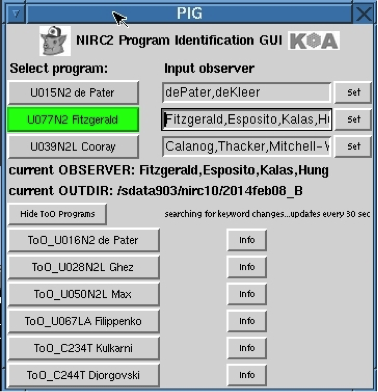
|
| Figure 1. PIG displaying the list of approved ToO programs. The "Show ToO Program" buttons toggles to a "Hide ToO Programs" button when clicked. |
After the observation is complete, or if the ToO observation is rejected, observers need to complete a ToO Interrupt Reporting form (see Figure 2). This new form is available from a link on the observing team members’ Keck Observatory home page. This form will be used to gather feedback from the observing community (PIs of both the ToO and CSO teams) that will be used for future improvements. WMKO is always looking for ways to maximize science productivity and this limited implementation of TDA is an attempt to do just that. We appreciate your cooperation during this trial semester and your feedback is encouraged.
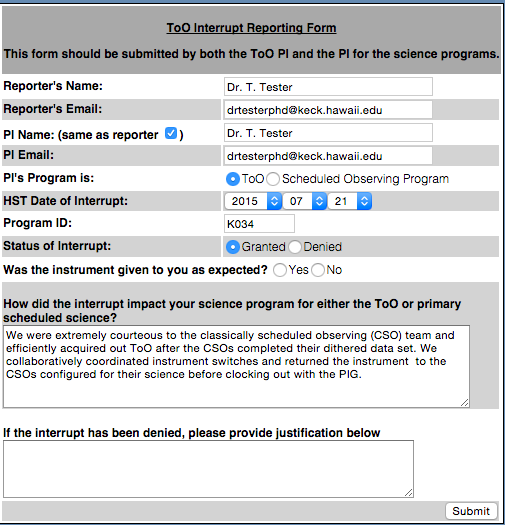
|
| Figure 2. ToO reporting form with Fields completed as an example. ✶ |
New Vortex Coronograph in NIRC2
Bruno Femenia-Castella, Adaptive Optics Scientist, WMKO
Hien Tran, Support Astronomer, WMKO
New vortex coronagraphic masks were recently installed in NIRC2 for use at L band, adding a new powerful capability for high-contrast imaging. This coronagraph concept was described in Mawet et al. (2005) and its key element is a vortex phase mask consisting of concentric annular grooves etched in diamond. This type of coronagraph is currently among the most promising high-contrast imaging devices. Absil et al. (2014) report laboratory L band contrast ratios up to 6 x 10-6 (which corresponds to a ~ 500:1 peak rejection) at angular separation of just 2λ/D.
The project to install the vortex masks in NIRC2 was led by E. Serabyn (JPL) with D. Mawet (CIT) as co-IP. This project is the result of a collaboration between JPL, CIT, the European VORTEX group (led by O. Absil from U. Liège) and WMKO (led by P. Wizinowich). Part of this team has also been involved in the installation of the vortex masks at Palomar, VLT (Mawet et al. 2013) and LBT (Defrère et al. 2014). Under the direction by K. Matthews (CIT) the Keck vortex coronagraphs were installed in NIRC2 on March 17, 2015, replacing, at the focal plane, the grids of holes used for focusing and distortion tests on the slit mask stage (SLS), which also holds the spectroscopic slits and a number of conventional (pure amplitude) coronagraphic masks. The grids of holes have been removed from NIRC2 and are no longer available, but the old set of conventional coronagraphic spots with variable sizes, as well as the slits, are still available.
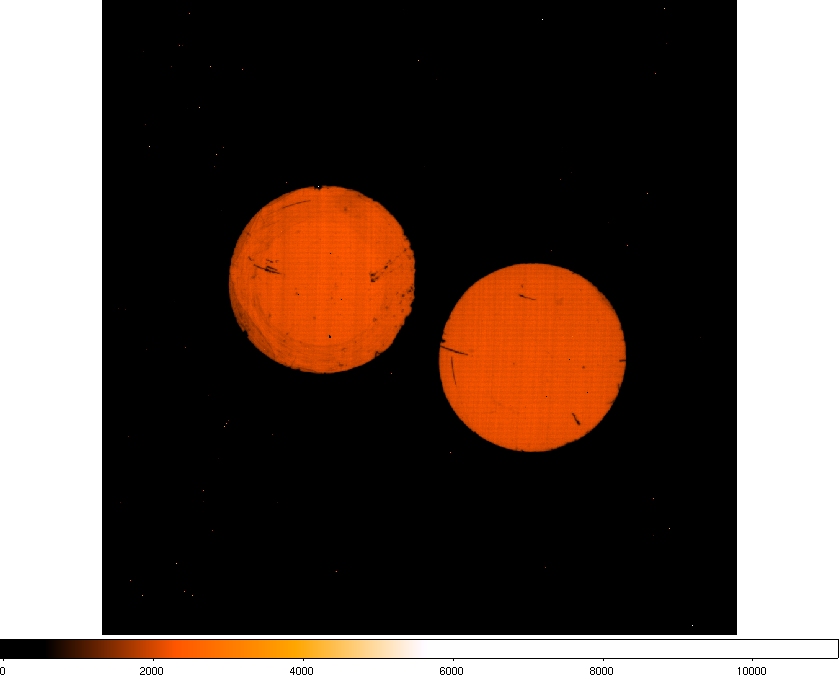
|
| Figure 3. Two vortex masks as seen by NIRC2 wide camera at L band. Each mask subtends ~12″ on sky. |
A number of changes on the Keck II AO bench have also been made to improve the image quality and to support this new capability. These include: the rotation of the AO dichroic, re-alignment of the off-axis parabolas, and a re-alignment of the K mirror. These improvements have effectively eliminated a previously known image elongation at L band. We developed new tools to accurately position the vortex mask and we ran daytime tests which indicated ~100-150:1 peak rejection. We also characterized the accurate positioning of the light source onto the vortex mask by issuing appropriate centroid offsets to the AO wavefront sensor. The ability to position the starlight on the mask to within a few mas accuracy is critical to the vortex performance.
The NIRC2 vortex underwent its first commissioning run during the nights of June 8–10, during which we were able to achieve a pointing precision down to ~1 mas level, exceeding the requirement of 8 mas. This was possible thanks to the deployment of a novel technique called Quadrant Analysis of Coronagraphic Images for Tip-Tilt Sensing (QACITS) developed by Huby et al. (2015). This is quite a remarkable achievement, considering that this was the very first time QACITS has been used on sky. The improved image quality, combined with the excellent seeing conditions encountered during commissioning, allowed us to routinely achieve Strehl ratios above 85% at L band, and peak starlight rejection of ~50:1, with occasional excursions into the ~100:1 regime. Despite the system being commissioned with new user tools for acquisition and positioning still under development, we also achieved a very high observing efficiency with minimal overheads. The first commissioning results appear very promising, as shown in the contrast curve below. The data acquired during this commissioning run also show a major science result, to be published shortly, demonstrating the capability of the new system.
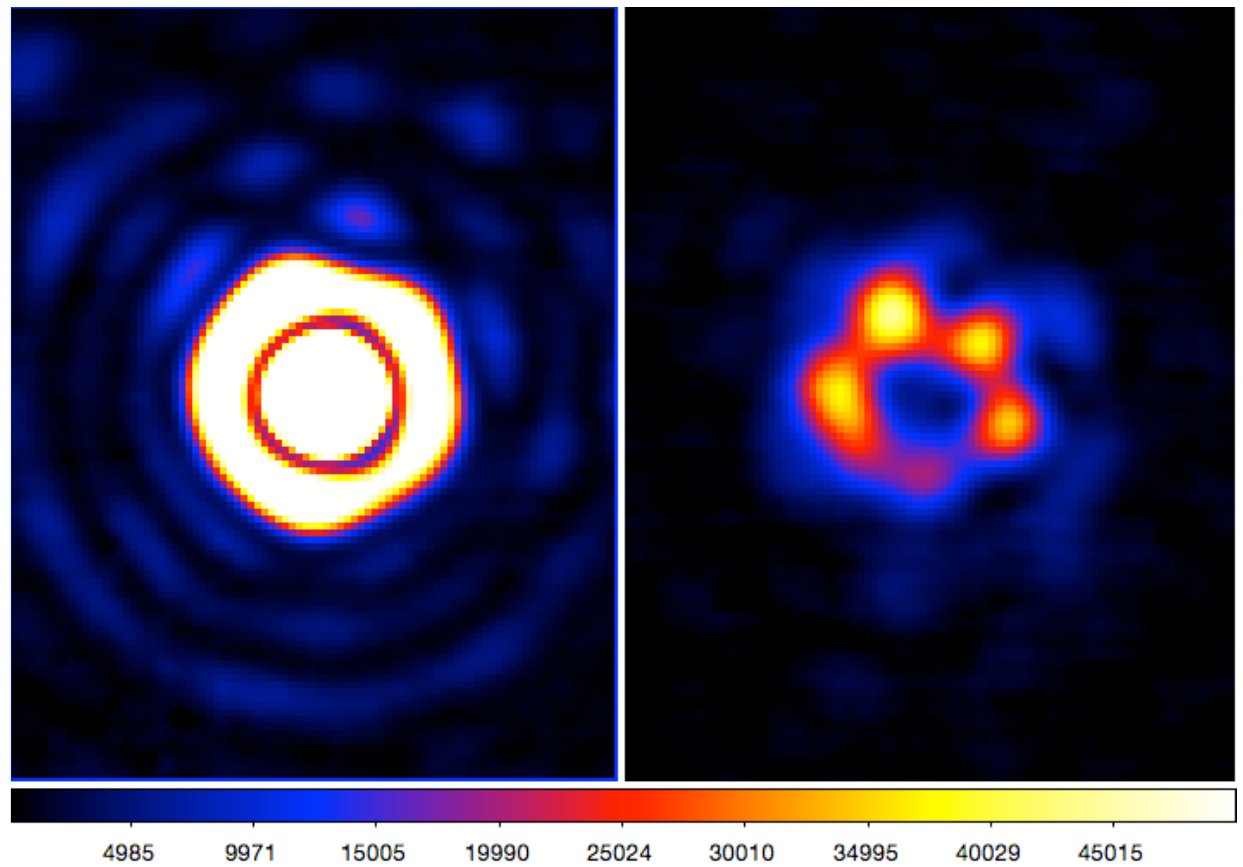
|
| Figure 5. Typical PSF in the L band with Strehl ratio of up to 88%, and many diffraction rings visible. |
We have a few more commissioning nights scheduled in October to refine the QACITS technique to center the star on to the vortex, and suppressing the residual speckle pattern noise shown in Figure 5. This will be done by including advanced focal-plane wavefront sensing with speckle nulling and/or a phase diversity approach applied to coronagraphic images (COFFEE Paul et al. 2014). Though a final decision is still to be made, the plan is to offer the vortex and the new software to the Keck community in 2016 A. For the time being the vortex is available in shared-risk mode. ✶
The Keck Cosmic Web Imager: Opening the Era of Optical, Wide-Field, Low Surface Brightness Integral-Field Spectroscopy at the Keck Observatory
Luca Rizzi, Support Astronomer, WMKO
Sean Adkins, Instrumentation Program Manager, WMKO
The Keck Observatory is pleased to announce the upcoming arrival of the newest addition to the complement of instruments available to our observers: The Keck Cosmic Web Imager (KCWI). The instrument will undergo a pre-ship review at Caltech in September, and soon after will make its way across the Pacific Ocean and up to Maunakea. The instrument will be located at the right Nasmyth focus of the Keck II telescope.
KCWI was developed by Caltech, UCSC and UCO, with support provided in part by the National Science Foundation’s Telescope Systems Instrumentation Program, the Heising-Simons Foundation, the Friends of Keck Observatory, and by observatory operations funding. The instrument is the result of the tireless effort of Chris Martin (Caltech, PI), Patrick Morrissey (Caltech, PS), Connie Rockosi (UCSC lead) and Sean Adkins (WMKO Instrument Program Manager).
KCWI is a seeing-limited integral field spectrograph optimized for precision sky-limited spectroscopy of low surface brightness phenomena. It features high throughput and great flexibility in field of view, spatial sampling, bandpass, and spectral resolution. While only the blue channel will be delivered at this time, in its final configuration KCWI will provide full wavelength coverage (0.35 to 1.05 μm) using separate blue and red channels.
KCWI is based on the Cosmic Web Imager (CWI), a seeing limited integral field spectrograph now routinely used at the Palomar Observatory. CWI is a single channel instrument with a fixed spatial sampling scale, a single adjustable volume phase holographic (VPH) grating and an articulated camera with 2k x 4k mid-band optimized CCD.
At the core of KCWI is a set of three image slicers, offering three sampling scales and three corresponding fields of view. The 0.35" sampling scale provides a field of view that is 8.4" x 20", the field of view for the 0.7" sampling scale is 16.8" x 20", and the field of view for the 1.4" sampling scale is 33.6" x 20". The instrument is equipped with a selection of volume phase holographic gratings allowing for a range of spectral resolutions from 1,000 to 20,000. The optical configuration of KCWI is illustrated in Figure 6 and the key performance parameters are listed in Table 1.

|
| Figure 6. KCWI optical layout. |
The instrument is constructed on a large optical bench with the large common optical elements and the red channel of the spectrograph mounted on top of the optical bench. The blue channel of the spectrograph is mounted underneath the optical bench. The light at the Keck II telescope Nasmyth focal station passes through an instrument hatch and the windowed k-mirror de-rotator to the integral field unit selectable image slicer stack located at the telescope focus. The slicer stack sits on a linear stage that selects between 3 slicer formats and a direct imaging alignment camera. A calibration system with a deployable periscope mechanism (not shown in Figure 6) directs calibration light onto the image slicer. The image slicers are slightly curved to re-image the telescope pupil onto the VPH gratings used in each channel. The light from the integral field unit pupil array proceeds to a spherical collimator and then to a wavefront-correcting cylindrical mirror (FM1), completing the portion of the optical path common to the red and blue channels. Not shown in Figure 1 is the standard observatory MAGIQ guide camera which provides for guiding and acquisition.
The light from FM1 is split into the red and blue bands by a large dichroic beam splitter. The blue passband is reflected through the optical bench to a final fold mirror in the blue spectrograph channel (FM3). When the instrument is first delivered in the blue channel only configuration a flat mirror will substitute for the dichroic. At the entrance of the spectrograph there is a band pass filter and a set of volume phase holographic transmission gratings. The filter and gratings are removed and replaced in the light beam by an automated grating and filter exchanger. After the filter and grating the dispersed light from each slice of the IFU is imaged onto the blue channel’s 4k x 4k CCD detector by a 9 element all spherical camera.
The optical arrangement of the red channel will be similar to the blue channel.
With its impressive flexibility, KCWI will be a key player in a number of scientific topics, such as: young stars and jets, evolved star nebulae, light echoes, star clusters, low surface brightness galaxies, star formation in extreme regimes, galactic halos, thick disks, streams, intra-cluster light, AGN/QSO/Galaxy co-evolution, the circum-QSO medium, low and high-redshift galaxy structure, the circum-galactic medium, Lyα emitters and blobs, and emission from the IGM/Cosmic web.
At the time of writing, the instrument is in the integration and test phase at Caltech. A view of the integration in progress is shown in Figure 7.
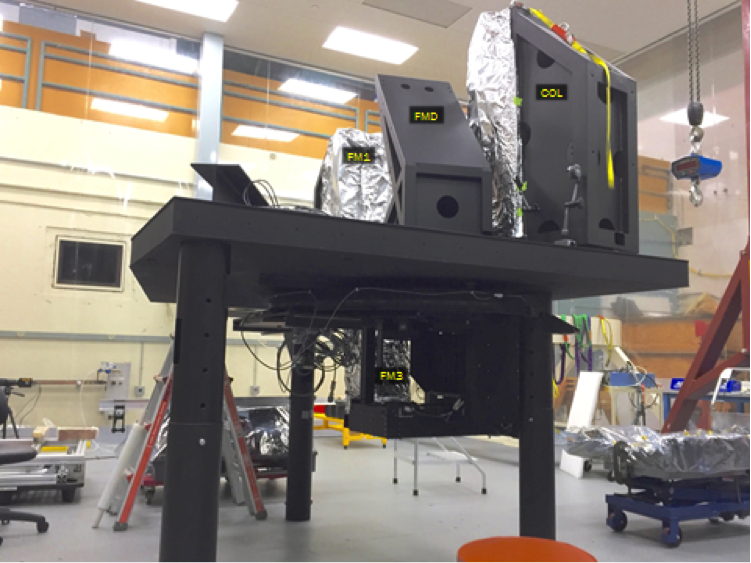
|
| Figure 7. KCWI integration in progress showing the optical bench and the large mirror optics. |
The instrument will be provided with an IDL-based data reduction pipeline which has been developed by Don Neill (Caltech) using the expertise acquired reducing CWI data at Palomar. While not strictly necessary for observations, the pipeline will also have a quick-look mode that will help observers to assess the quality of their data in real time.
Given the close similarities between KCWI and CWI, we can have a first look at the data produced by KCWI by looking at recent CWI spectra acquired at Palomar (Figure 8 below).
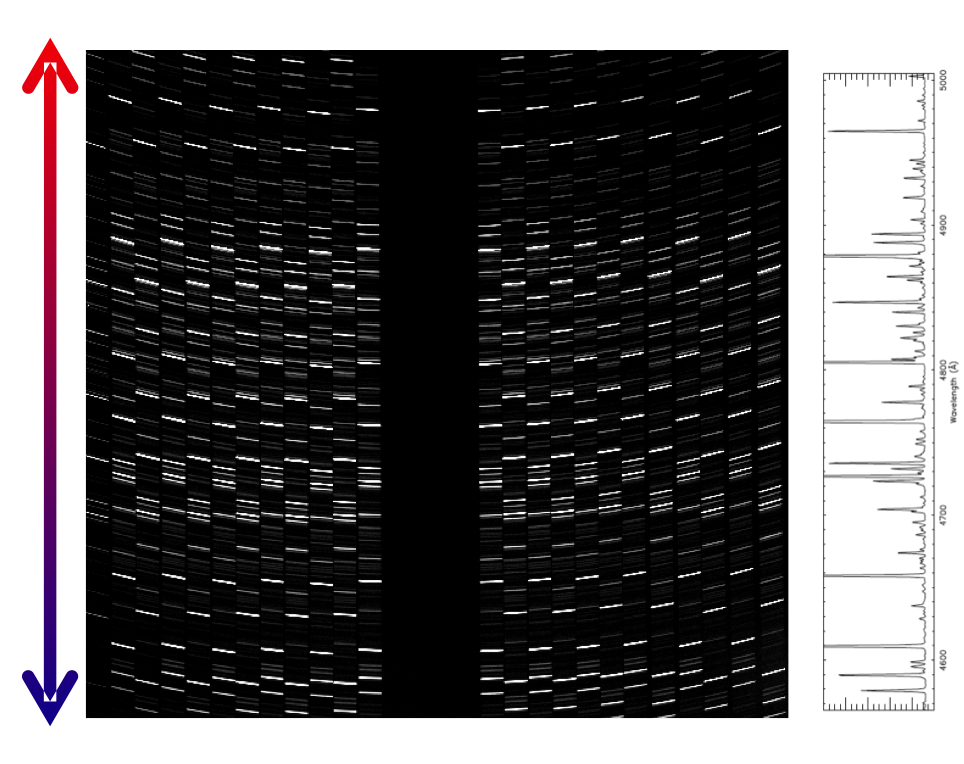
|
| Figure 8. Example CWI spectral image. The vertical axis is the wavelength. The 24 slices are shown side-by-side on the mosaic. The image is an arc lamp. |
Each of the 24 slices produced by the image slicer are dispersed into a spectrum that nicely fits on the detector. The final data product is a data cube with spatial directions along the X and Y axes, and wavelength along the Z axis.
One of the most interesting features of this instrument is the possibility of observing in Nod & Shuffle mode. To achieve the best possible sky subtraction, this mode sacrifices wavelength coverage by using a mask to block the top and bottom part of the detector, leaving the central third exposed to incoming light. The sequence of observing starts with a sky integration of half the individual exposure time, followed by shuffling of the charges and a science exposure. After a number of alternate sky and science observations, the sequence is completed by a final sky exposure of half the individual exposure time, and the detector is readout. With this technique, which is fully supported by the pipeline, the instrument should be able to achieve a sky subtraction to better than 10-4. A special GUI will be provided to plan Nod & Shuffle observations, so that complicated observing patterns can be accomplished in a completely automatic way.
Control of the instrument will be very similar to the current setup for OSIRIS and MOSFIRE, using a highly customizable desktop interface shown in Figure 9.

|
| Figure 9. KCWI desktop interface under development. |
Once it arrives at Keck, the instrument will be thoroughly tested and commissioned during the remaining of semester 2016B and the beginning of 2017A, and will be offered for shared-risk observing in 2017B.
We are anxiously waiting for this new, exciting instrument, which will open up a wealth of new capabilities for the Keck Observatory, and we wish all the best to the instrument team for the final phases of integration and testing. ✶
OSIRIS Double Detector Upgrade and DRP Update
Jim Lyke, Support Astronomer, WMKO
The first of two detector upgrades for OSIRIS has been installed in the dewar and is undergoing testing. The spectrograph detector upgrade replaces the current Hawaii-2 detector with a H2RG. The new detector offers better noise performance, reduced dark current, and fewer detector artifacts that must be removed by the data reduction pipeline (DRP). The SPEC upgrade is an NSF ATI award with James Larkin of UCLA as the PI, Richard Ellis and Sean Adkins as Co-Is. OSIRIS went off line at the end of December 2015 for the upgrade and is scheduled to be back in April 2016. We will release DRP updates designed to make data reduction seamless for the observers.
The second detector upgrade for the OSIRIS imager is scheduled for early 2017. In addition to a H2RG detector to replace the original Hawaii-1, new optics have been designed that will preserve the 20″ FOV, but now with 10 mas pixels. The IMAG upgrade was made possible with a grant from the Gordon and Betty Moore Foundation with Andrea Ghez and Mike Fitzgerald of UCLA as co-PIs.
Keck Observatory and several interested observers have been investigating a number of issues related to the DRP. New rectification matrices were released in September 2015 that appear to have greatly reduced the numbers of bad spaxels with high absolute values. Additionally observers have noticed lower SNR in reduced data versus raw data and "echos" of bright sources in their reduced data. These issues have not been solved, but Keck is committed to fixing them.
Following on the successful MOSFIRE DRP repository on GitHub, we have added one for the OSIRIS DRP. After the SPEC detector upgrade, Keck plans to use GitHub to distribute the OSIRIS DRP. Some of the benefits offered by this system are an issue tracking infrastructure and distributed development tools.
If you have concerns with your OSIRIS data, please report your issue on the OSIRIS DRP GitHub site or to osiris_info@keck.hawaii.edu. ✶
MOSFIRE Pipeline Release 2015A
Luca Rizzi, Support Astronomer, WMKO
Slightly over a year ago, the Keck Observatory accepted the responsibility for developing, supporting and distributing the MOSFIRE pipeline originally developed by the MOSFIRE team (Chuck Steidel and Nick Konidaris).
After an initial release in January of 2015, we are announcing the second release of the pipeline, under a new naming scheme that we will adopt from now on. The current release is named 2015A, indicating it is the first release of the year using the new name.
This release provides a number of new capabilities and improvements as well as bug fixes. It also highly enhances the automation of the reduction process. Among the new capabilities, the pipeline now offers:
- Automatic generation of the driver file. There is no need to copy a driver file from the drivers directory and edit it, just run “mospy AutoDriver” in the directory containing the “Offset*” files and a Driver.py file will be produced.
- Reduction of LONGSLIT observations. Longslit mode is fully supported. If multiple longslit observations are obtained in the same night, a separate driver file is produced for each of them, and the target name is included in the final reduced files.
- Reduction of long2pos and long2pos_specphot. Observations obtained with the long2pos mask can now be reduced and a driver file for the reduction process may be automatically generated using the “mospy AutoDriver” command.
- Detailed log file and log output. Rather than using print commands to communicate the results, the pipeline now uses the python logging facility, providing both very detailed information on the terminal and a log file on disk that can be examined at a later time.
- K-sigma clipping of the wavelength fit. During the manual fitting phase, the user now has the option of automatically rejecting bad lines using iterative k-sigma clipping (the key is “k”).
- Bypass mode during interactive fitting. In the previous version, bypass mode (automatic fitting) was either always on or always off during the fitting phase. Now, the user has the ability of starting the fit in manual mode to check the accuracy on a couple of slits, and then switch to bypass for the rest of the fit if the first few slits are fit correctly.
- Package installation. The pipeline can now be installed both in the standard way (downloading zip or tar files), or using a more standard python way as an ureka package. Instructions are provided in the manual.
- Support for Numpy 1.9. The requirement that the user keeps a copy of ureka 1.4.1 (numpy 1.8) has been abandoned, and the pipeline is now compatible with ureka 1.5
During the year, a number of users have started using our issues tracking page, and we have been able to solve most of the requests submitted. We invite users to visit the page to see if any of the available posts can help address their questions. Comments and suggestions are also welcome.
We plan to release a new version every six months or so, until we reach a rather stable and complete pipeline. After that, releases will be provided if new functionalities are being implemented or if major bugs are discovered. For the future, we plan to provide a spectral extraction module, and possibly a set of tools to perform telluric correction. ✶
Back Issues
Please see the Keck Observers’ Newsletter Archive.

